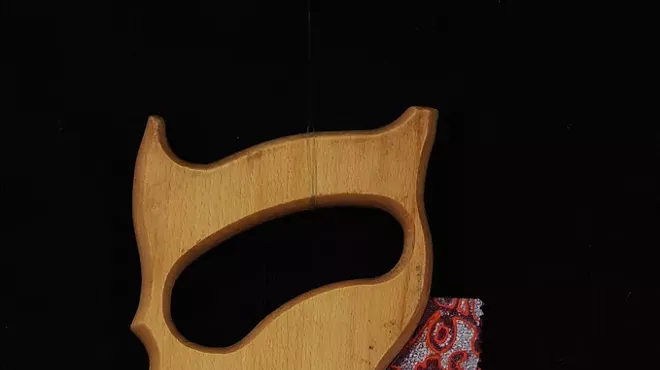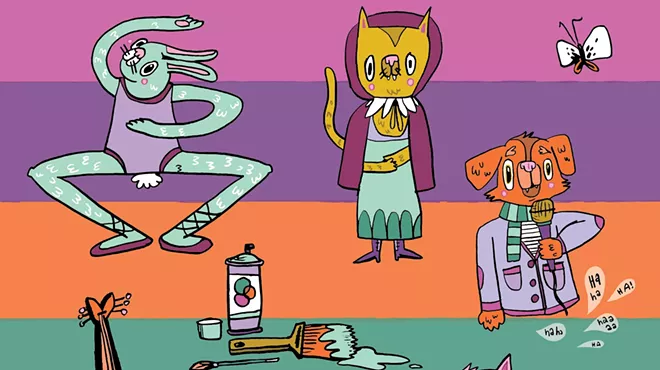"There's a million things I want to do," says Ben Joyce. "And I feel like it's taken me 22 years to get to the starting line."
As he says these words, the Spokane-based visual artist is standing in front of a piece titled after his home city, an irregular canvas where bold color blocks reminiscent of Mark Rothko are bordered by distinct lines representing the Spokane River or Northwest Boulevard. It's part roadmap, part sensory impression.
He painted "Spokane" back in 2006, a time when he was still formulating the unique style that he would dub "abstract topophilia." However you might label it, it all boils down to capturing and sharing a love of place, Joyce says.
"For as long as I can remember, I've just been fascinated with place and that connection to it."
"Spokane" is the first artwork that visitors will encounter at "Places: Ben Joyce," a new exhibition of Joyce's work that opened last weekend at Gonzaga University's Jundt Art Museum and is on display until early 2025. The early piece is situated at this introductory point because it features the elements that would become hallmarks of Joyce's distinct style: the puzzle-piece shape, the visual interplay of the natural world and the human-made, the universally identifiable aerial view filtered through an artist's deeply personal lens.
By any account other than his own, Joyce is well beyond the starting line when it comes to his art, something that this exhibition should attest to. The inclusion of "Spokane" provides a developmental benchmark for the seven ambitious, large-scale works that follow.
Each of the pieces is based on a different domestic or international location and was created over a five-year period as part of PLACES, a larger project that saw Joyce accompanied by filmmaker Rudy Valdez. That documentary film will be released later this year.
The on-site visits that informed the pieces in this collection began in 2019 in New York, where Valdez is based. As part of his backgrounding process, Joyce explored the city, researched its history and interviewed people on location.
He distilled those accounts and firsthand experiences into a 350-pound work that, like its counterparts in PLACES, makes use of multiple media, palpable textures, overt and coded symbolism, and physical omissions.
In "New York," viewers can spot subway graffiti and street art, sports team logos, and ghostlike representations of immigrants converging on Ellis Island. The area that is recognizably Queens is filled with dynamic Jackson Pollock-style paint trails that seem to trace the peripatetic routes of its residents.
"It's not only the energy and confined chaos of an everyday life," Joyce explains. "It's also, you know, you think of all of these different cultures merging in one place."
After New York, Joyce returned to the Pacific Northwest to visit and study Seattle. Music features heavily in the piece he created. Even casual observers will be able to spot Nirvana lyrics, Pearl Jam album covers or the purple haze hovering above the Jimi Hendrix memorial. But Joyce also channeled significant experiences from his personal life into his artwork.
"Seattle has played a big part in our lives," he says. "I have a special needs daughter, and we've gone to Seattle Children's. So Seattle Children's is highlighted. I painted a couple of the cherry blossoms, but one of them, the actual flower, is the location of the hospital."
For similar reasons, PLACES doesn't only draw on large conurbations like New York, Seattle, Los Angeles and Rome, Italy. Joyce's mother's hometown of Butte, Montana, is represented here, beautifully pockmarked by the cratered relief of the Berkeley Pit. The city's mining history is further captured by copper hues and the subterranean network of tunnels that carve into the bottom right corner of the artwork.
Through Jan. 4, Open Mon-Sat from 10 am-4 pm, free
Jundt Art Museum, 200 E. Desmet Ave.
gonzaga.edu/jundt, 509-313-6843
"There were, like, 2,400 miners in an 80-year period that passed away in the mines," Joyce says. "But there's just this fight and grit that people from Butte have. So I'm just trying to pull all of that story into [this] piece."
The Hawaiian island of Maui is depicted in PLACES, too, as is Florence, Italy. The latter is where Joyce took part in a study abroad program while still a Gonzaga undergrad, and he identifies the Tuscan city — not least because of its rich artistic and architectural legacy — as the site where he first felt dissatisfied with the limitations of conventional painting.
"Florence inspired me to do a completely different style of work. It's where everything just kind of culminated into this moment of inspiration, and although I didn't understand what it was, I knew that traditional landscapes weren't the path I wanted to take."
That path would ultimately lead to yearslong, globe-spanning multimedia projects like PLACES, although Joyce is still letting some of the twists and turns of his career sink in. He may have established himself as a singular artist, sought after by collectors, but this is the first time his mature work has been presented in this kind of format.
"I was thinking about it," he says, smiling, "and the last time I actually had an exhibit of my work was 24 years ago when I was a senior here." ♦
































